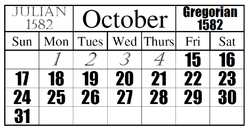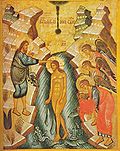Julian calendar
Lua error in package.lua at line 80: module 'Module:Ancient Olympiads' not found. The Julian calendar, proposed by Julius Caesar in 46 BCE (708 AUC), was a reform of the Roman calendar.[1] It was first used on 1st January, 45 BCE. It was the main calendar in most of the world, until Pope Gregory XIII replaced it with the Gregorian calendar on 4 October 1582.
During the 20th and 21st centuries, the date according to the Julian calendar is 13 days behind the Gregorian date.
Year length; leap years
The Julian calendar has two types of year: common years of 365 days and leap years of 366 days. There is a simple cycle of three common years followed by a leap year and this pattern repeats forever. However, the rule was not followed in the first years after the reform in 45 BCE. Due to a counting error, every 3rd year was a leap year instead of the 4th. The leap years were:[2]
- 45 BCE (709 AUC)
- 42 BCE (712 AUC)
- 39 BCE (715 AUC)
- 36 BCE (718 AUC)
- 33 BCE (721 AUC)
- 30 BCE (724 AUC)
- 27 BCE (727 AUC)
- 24 BCE (730 AUC)
- 21 BCE (733 AUC)
- 18 BCE (736 AUC)
- 15 BCE (739 AUC)
- 12 BCE (742 AUC)
- 9 BCE (745 AUC)
However, in 8 BCE (746 AUC), emperor Augustus Caesar corrected the problem. The next leap year was 7 CE (760 AUC).
Criticism
With the simple cycle, the length of the Julian year is exactly 365.25 days (365 days and 6 hours), but the actual time it takes for the Earth to go around the Sun once is closer to 365.2422 days (about 365 days, 5 hours, 48 minutes and 46 seconds). This difference is about 365.25 - 365.2422 = 0.0078 days (11 minutes and 14 seconds) each year, although Greek astronomers knew that.[3] This made the seasons get out of track, since the real first day of spring in western Europe (the equinox - day and night the same length) was happening earlier and earlier before the traditional 21 March as the centuries went by. By the 1500s, it was starting around 11 March, ten days 'too early' according to the calendar.
Reform
From Roman calendar
The first step of the reform was to realign the 25 December with the Winter solstice by making 46 BCE (708 AUC) 445 days long. In ordinary Roman calendar, the common year had 355 days and the leap year (one year after the common year) had 378 days. The 46 BCE was a leap year, according to the calendar. Julius Caesar added 67 more days by adding two extra months (those are called Prior and Posterior in letters of Cicero) between November and December.
| Months | 47 BCE (707 AUC) |
46 BCE (708 AUC) |
45 BCE (709 AUC) |
8 BCE (746 AUC) |
|---|---|---|---|---|
| January | 29 | 29 | 31 | 31 |
| February | 28 | 24 | 30 | 28 |
| Intercalaris | 27 | |||
| March | 31 | 31 | 31 | 31 |
| April | 29 | 29 | 30 | 30 |
| May | 31 | 31 | 31 | 31 |
| June | 29 | 29 | 30 | 30 |
| Quintilis | 31 | 31 | 31 | 31 |
| Sextilis | 29 | 29 | 30 | 31 |
| September | 29 | 29 | 30 | 30 |
| October | 31 | 31 | 31 | 31 |
| November | 29 | 29 | 30 | 30 |
| Prior | 33 | |||
| Posterior | 34 | |||
| December | 29 | 29 | 31 | 31 |
| Total | 355 | 445 | 366 | 365 |
Julian Calendar Media
The Tusculum portrait of Julius Caesar
Russian icon of the Theophany (the baptism of Jesus by John the Baptist) (6 January), the highest-ranked feast which occurs on the fixed cycle of the Eastern Orthodox liturgical calendar
References
- ↑ Richards 2013, p. 595.
- ↑ Michael Douma (2008). Sally Smith (ed.). "The Christian Calendar | Calendars". WebExhibitsċċđ. Retrieved 2019-05-15.
- ↑ Claudius Ptolemy, tr. G. J. Toomer, Ptolemy's Almagest, 1998, Princeton University Press, p. 139. Hipparchus stated that the "solar year ... contains 365 days, plus a fraction which is less than [math]\displaystyle{ \tfrac{1}{4} }[/math] by about [math]\displaystyle{ \tfrac{1}{300} }[/math]th of the sum of one day and night".


